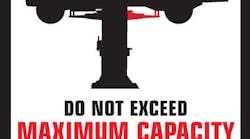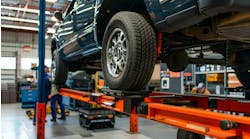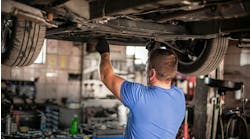How to choose the right lift for your shop
In choosing a lift for your shop, one of the most important questions to consider is: What’s the heaviest vehicle you’ll ever be raising to service? Answering this one question will give you the answers in your search to find the best equipment fit, whether you are lifting a fire truck or an everyday passenger car. A multitude of lifts exist such as the two-post, four-post, parallelogram, vertical rise, etc., but in this article, I’m going to focus on the most popular lift – the two-post lift.
Among shop owners, two-post side-by-side lifts are often the most common choice for purchasing, as they take up a minimal amount of shop space and provide a generous amount of under-vehicle access. Two-post lifts also leave the tires hanging free, are affordable, and can be installed quickly in just a few hours.
Two-post lifts range in capacities from 7,000 to 30,000 lbs., and this is where the question, “What’s the heaviest vehicle you’ll ever be raising to service?” comes into play. If you’ll never service more than a Honda or Chevy Impala, a 7,000- or 10,000-lb capacity lift will suit your needs. But what if a Ford-550, an ambulance, or a service truck comes to the shop for repair? What if these vehicles are suddenly your new customers or your business changes? If that happens, it should be a red-flag that it’s time to consider a heavier capacity two-post lift.
Consider where you live, too. If you live in metro LA or Boston, then most of the population drives small cars. If you’re in a more rural part of the country there’s a higher population of trucks, and so you might consider a heavier capacity lift.
When considering capacity, don’t just look at the total weight of the vehicle. Per the Automotive Lift Institute (ALI), – the safety organization of lift companies in the U.S. and Canada – a two-post lift with a 12,000-lb capacity rating has a maximum per arm capacity of 3,000 lbs. If a service truck has a rear axle capacity of 8,400 lbs. and front axle capacity of just 3,000 lbs., be aware that the 12,000 lb lift would be overloaded by 1,200 lbs on each of its rear arms. Even though the total weight of the truck is under 12,000 lbs., the lift is still being pushed past its capacity. Don’t make the mistake of saving a few dollars by buying a lower capacity lift as you could be risking your safety and the safety of your employees, customers and the vehicles you service. Pay attention to the warning decal. It is supplied on two-post lifts as a visual reminder to not exceed maximum capacity per swing arm.
Another simple question to ask yourself before buying, and an often-overlooked feature, is how high must the lift rise before the mechanical locks start to engage? While the ALI advises to always lower the lift onto the locks, if there are no locks, then your lift is only being held up by hydraulic pressure. Some lift brands have their locks starting at 2-3 inches off the ground and some don’t start until 24 inches. These manufacturers are trying to save a few dollars by not designing safety locks that engage at every height. When buying, keep in mind, you or your techs will be operating under these safety locks.
Another feature of lift locks to consider is the indicator of whether the locks are being used. One lift manufacturer offers a light on top of the column which lights when the lift is on the locks. Other lift manufacturers offer a pressure gauge, calibrated to the weight of the vehicles being lifted. This “scale” reads 0 lbs when the lift is lowered onto the locks.
However, as a diagnostic tool, if a customer is complaining of poor mileage, the car pulling, or that the inexpensive brake pads have prematurely worn, the weight gauge becomes a diagnostic tool. Just raise the vehicle and given the weight shown on the “scale”, the scale now becomes the method by which to show your customer why they should buy better ply tires, higher quality brake pads, or load levelers instead of shocks (all increasing your shops revenue per repair).
Lifts are designed to save time to make your shop more money. For example, on average, a tech spends 5-6 minutes positioning the lift’s swing arms before raising the vehicle. Now consider the option of a drive-on ramp that still leaves the tires hanging free for brake, tire, and front-end work, as well as eliminating the five minutes of positioning the arms (per vehicle). Multiply that by the number of vehicles repaired in that bay weekly/monthly/yearly, and you’ll see some lifts have the potential to pay for themselves in less than a year.
One of the most overlooked two-post lift features is the minimum height of the arm when fully retracted. Stated a different way, will the arm fit under some low riding sports cars, low profile tires, or a car with sagging springs? Be sure to look, as research shows some lifts are considerably lower than others. Not having a low enough arm may mean using a floor jack to raise the car in order to get the swing arms under the proper lifting points, costing you time and money.
Per the ALI, ANSI (American National Standards Institute) and the International Code as adopted by all 50 states, a lift is to be certified to the ALI standard. If you were to buy a non-certified lift, and the building inspector comes in for a visit, not having a certification validation of the lift may lead to your lift being locked out/tagged out. Meaning you’d have an unusable and worthless lift preventing you from making money in that bay. In addition, not only must the lift be ALI certified, but all options used with the lift (think truck adaptors used on every pick-up) must be certified. Per the ALI website, “Use of a non-certified option will void the certification of the lift.” Be sure to verify the lifts you’re considering before purchasing.
Simply stated, when purchasing a lift for your shop take the time to consider all the features that will be most useful to you and be willing to spend the money to get the right lift. Remember, a great price on the wrong piece of equipment is still the wrong piece of equipment. Safe lifting.




